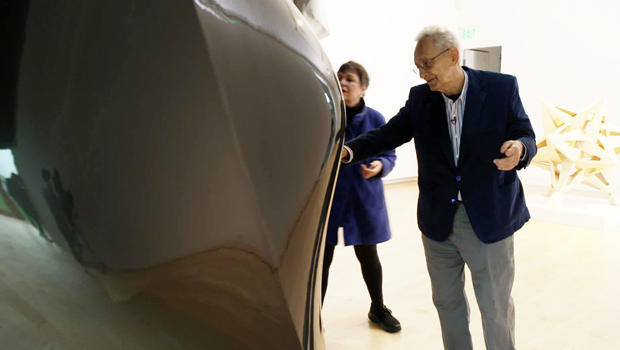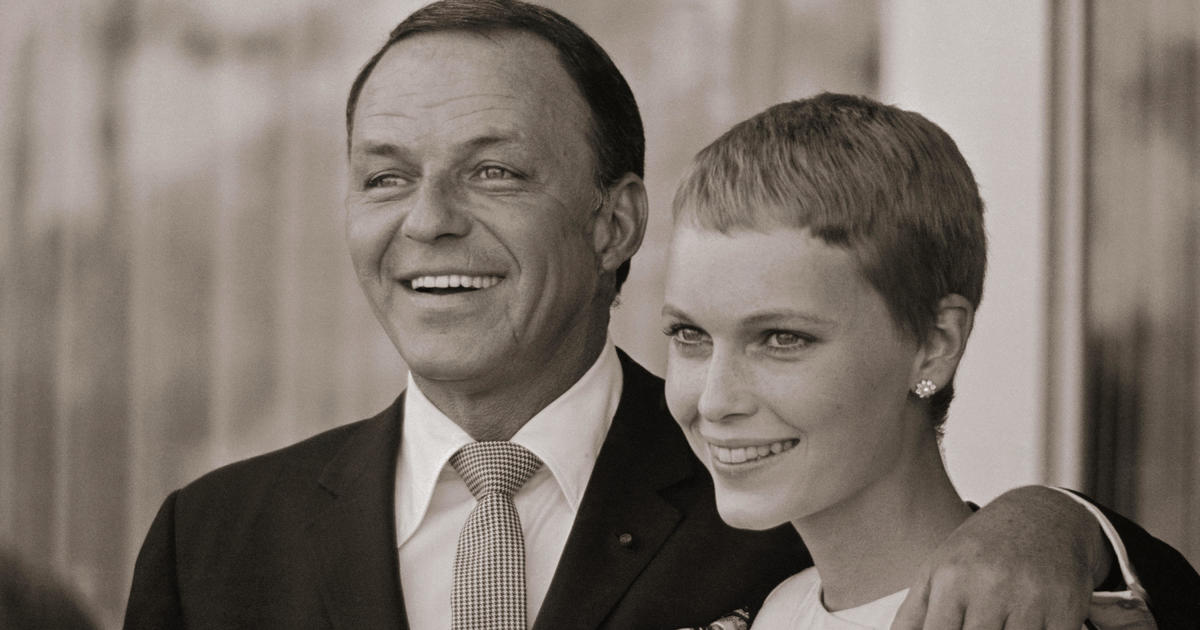Frank Stella on his artistic obsessions
Frank Stella's name means star in Italian, and for decades that was the problem, the reason he stopped making them. "When I started out, I didn't really want to hear about, 'My name was Stella and I made a shape painting of a star.'"
But then, computer design technology came along, and 3-D printing. Suddenly the star had possibilities.
"It's pretty easy to put them together and turn them around and see how they look," he said, showing off his star models.
The Aldrich Museum of Contemporary Art in Ridgefield, Connecticut, has gathered a small galaxy of Frank Stella's stars, old and new.
They may look really different from each other to you or me, but to the artist, they have something in common other than being stars. ""They're surfaces to paint on," he said, "and I guess that's why I say, 'Look, it's still about painting, in a way.'"
It's always been about painting. Even six decades ago, when the paintings looked like this …
In 1959, New York's Museum of Modern Art put some of them in a show, and then bought one. Just out of Princeton, in his early 20s, Stella was a star. He's been one ever since.
Whether in the auction prices his work commands, or the accolades he's received, Stella is recognized among America's greatest living artists. According to The New Yorker, he is to abstract art what Bob Dylan is to music.
Those painted surfaces Stella talks about? They've changed – a lot – over the years, morphing into giant collages, that turned into sculpture, and then headed in the direction of architecture.
Correspondent Martha Teichner asked Stella, "Why abstraction versus figurative?"
"'Cause I didn't like people that much," he laughed. "Yeah, yeah, I mean, you know, everybody was doing that, or I didn't wanna spend a lot of time drawing from the model. You know when you see that poor girl sitting up there on that chair after she has to take off her bathrobe and everything, it's pretty pitiful!"
As Stella pushed the boundaries of abstraction, along the way he developed a few artistic obsessions. It's been 20-something years since Stella became fascinated with the idea of turning smoke rings into art. That's how we started our story when "Sunday Morning" profiled him in 2007:
But fourteen years later, the smoke rings evolved. They're free-floating, three-dimensional, made out of slick, painted fiberglass or aluminum tubing. It even looks huge in Stella's airplane hangar-sized studio in Upstate New York, which resembles a meander through his brain at various points in his career.
"I guess you'd say I'm restless, up to a point," he said. "Yeah, I can't help it."
At 84, he's still tinkering with the forms that interest him.
He showed Teichner a black model of a sculpture which he called a "puff star," made from carbon fiber.
"It allows it to be curved?" asked Teichner.
"Yeah, that's what makes it expensive!"
These models only hint at their full-size versions, as seen at the Aldrich. "This looks like it's coming after me," Teichner said.
"Yes, but it's contained in here quite a bit, so it is looming, as they say."
It certainly is. The one in the show at the Aldrich is 21 feet in all directions.
Stella waxed about the feeling of the material: "The people who did the carbon fiber, they do work for Formula One," as in race cars.
Teichner asked, "Were you happy with the results?"
"Are you kidding? It's actually beyond my imagination," he replied.
That's saying something for a man perpetually doing battle with what he sees as problems. Outdoors, he pointed to his sculptures on exhibit and said, "Outside, you don't know what's gonna happen. I mean, you know, Mother Nature's quite a difficult competitor!"
Frank Stella, who's spent a lifetime keeping the human form out of his work, admits that humanity has crept in anyway. "They feel quite comfortable here," he said.
"They feel comfortable? You talk about them like they're people."
"Well, they are," he laughed. "They have to have a certain kind of life of their own, and a presence of their own. They seem happy here."
Does that mean Stella has mellowed? That he's any less curmudgeonly about the arc of his long and (I'll say it) stellar career? Hardly.
He told Teichner, "I went from being a young artist to a middle-aged artist to a mature artist, and now I'm an is-he-still-alive artist?"
"Do you have any sense of what you'd like your legacy to be?" Teichner asked.
"Unh-unh, I don't. I'm not a legacy person," he said.
Ever the contrarian, he'd rather just hit rewind. "It would be probably a lot more satisfying to people if I'd started out like this, and then ended up with the black paintings. If you played my career back the other way, people would say, 'Oh, look, how fantastic! He ended up with those beautiful paintings at the end!'"
For more info:
- Frank Stella (artnet)
- "Frank Stella's Stars, A Survey" at the Aldrich Museum of Contemporary Art, Ridgefield, Conn. (through May 9)
- 1969 photographs of Frank Stella in his New York studio © Malcolm Lubliner
Story produced by Sara Kugel. Editor: George Pozderec.








